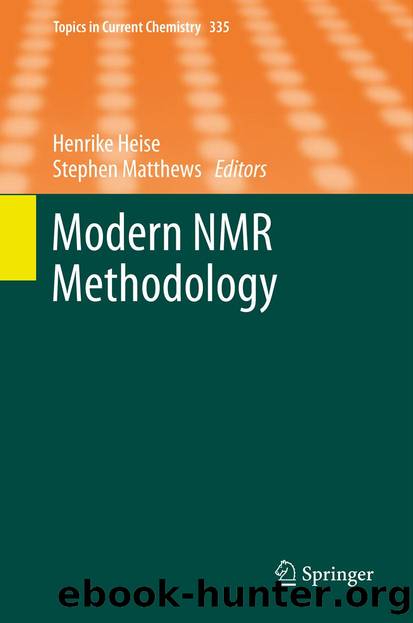Modern NMR Methodology by Henrike Heise & Stephen Matthews

Author:Henrike Heise & Stephen Matthews
Language: eng
Format: epub
Publisher: Springer Berlin Heidelberg, Berlin, Heidelberg
2 Preparation of Methyl-Labelled Samples
The first step of any NMR study is to make suitable samples. For large proteins, this is usually not trivial. NMR experiments need highly concentrated samples (~1 mM), which means that for bigger proteins more protein molecules have to be dissolved into a small volume. Aggregation has to be carefully avoided while solubility and stability are optimized by screening for the best buffer condition and temperature. The cost is always much higher than preparing small protein samples because deuteration is needed to remove of all the protons (except for the methyl protons of interest) to achieve the maximal effect of methyl TROSY. Deuteration is realized by growing cells in 100% D2O, which leads to slower growth rate and often lower protein yield. Several protocols have been reported to optimize the yield of deuterated proteins [16, 17].
Over the years, different methods have been developed for selective methyl protonation. An early trial used protonated pyruvate as the sole carbon source [18] and produced samples highly protonated at the methyl sites of Ala, Val, Leu and Ile (γ2 only), while most other sites were highly deuterated. Recently, it has been reported that using protonated glucose as the sole carbon source [19] resulted in ~50% of all the methyl groups labelled as CHD2, which could be selectively detected with a modified constant-time 1H-13C HSQC. These methods can be useful for studies of proteins below ~40 kDa, whereas for larger proteins, labelling methods with very little scrambling or isotopomers and more complete deuteration background are preferred. For such labelling protocols, deuterated glucose is used together with 100% D2O to achieve very high deuteration; suitable precursor(s) for methyl protonation are added into the media ~1 h before induction.
Download
This site does not store any files on its server. We only index and link to content provided by other sites. Please contact the content providers to delete copyright contents if any and email us, we'll remove relevant links or contents immediately.
| Automotive | Engineering |
| Transportation |
Whiskies Galore by Ian Buxton(41879)
Introduction to Aircraft Design (Cambridge Aerospace Series) by John P. Fielding(33064)
Small Unmanned Fixed-wing Aircraft Design by Andrew J. Keane Andras Sobester James P. Scanlan & András Sóbester & James P. Scanlan(32743)
Craft Beer for the Homebrewer by Michael Agnew(18140)
Turbulence by E. J. Noyes(7936)
The Complete Stick Figure Physics Tutorials by Allen Sarah(7307)
Kaplan MCAT General Chemistry Review by Kaplan(6867)
The Thirst by Nesbo Jo(6826)
Bad Blood by John Carreyrou(6552)
Modelling of Convective Heat and Mass Transfer in Rotating Flows by Igor V. Shevchuk(6391)
Learning SQL by Alan Beaulieu(6210)
Weapons of Math Destruction by Cathy O'Neil(6143)
Man-made Catastrophes and Risk Information Concealment by Dmitry Chernov & Didier Sornette(5921)
Digital Minimalism by Cal Newport;(5664)
Life 3.0: Being Human in the Age of Artificial Intelligence by Tegmark Max(5474)
iGen by Jean M. Twenge(5366)
Secrets of Antigravity Propulsion: Tesla, UFOs, and Classified Aerospace Technology by Ph.D. Paul A. Laviolette(5309)
Design of Trajectory Optimization Approach for Space Maneuver Vehicle Skip Entry Problems by Runqi Chai & Al Savvaris & Antonios Tsourdos & Senchun Chai(5011)
Pale Blue Dot by Carl Sagan(4912)
